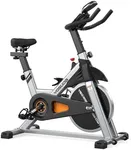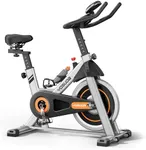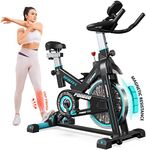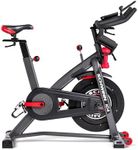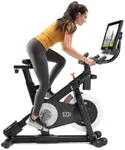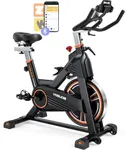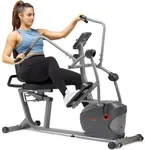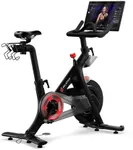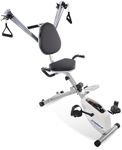Buying Guide for the Best Spin Bike
Choosing the right spin bike can significantly enhance your indoor cycling experience, making your workouts more effective and enjoyable. When selecting a spin bike, it's important to consider several key specifications that will impact your comfort, performance, and overall satisfaction. Understanding these specs will help you make an informed decision that aligns with your fitness goals and personal preferences.Flywheel WeightThe flywheel is the large wheel at the front of the bike that creates resistance as you pedal. A heavier flywheel provides a smoother and more stable ride, mimicking the feel of riding a real bike. Flywheels typically range from 30 to 50 pounds. If you're a beginner or prefer lighter workouts, a flywheel around 30-35 pounds may be sufficient. For more intense training and a more realistic road feel, opt for a flywheel in the 40-50 pound range.
Resistance TypeResistance on a spin bike can be either magnetic or friction-based. Magnetic resistance uses magnets to create resistance and is generally quieter and requires less maintenance. Friction resistance uses brake pads that press against the flywheel, which can be noisier and may require more upkeep. If you value a quiet and low-maintenance bike, magnetic resistance is the way to go. If you're looking for a more affordable option and don't mind a bit of noise, friction resistance could be suitable.
AdjustabilityAdjustability refers to how much you can customize the bike to fit your body. This includes the ability to adjust the seat height, handlebar height, and the distance between the seat and handlebars. Proper adjustability ensures a comfortable and ergonomic riding position, reducing the risk of injury. Look for a bike that offers a wide range of adjustments, especially if multiple people with different body sizes will be using it.
Drive SystemThe drive system connects the pedals to the flywheel and can be either chain-driven or belt-driven. Chain-driven systems are similar to outdoor bikes and can provide a more authentic cycling experience but may require more maintenance and can be noisier. Belt-driven systems are quieter, smoother, and require less maintenance. If you prefer a quieter and low-maintenance option, go for a belt-driven system. If you want a more traditional cycling feel and don't mind some upkeep, a chain-driven system might be better.
Console and ConnectivitySome spin bikes come with a console that displays workout metrics such as time, distance, speed, and calories burned. Advanced models may also offer connectivity features like Bluetooth, allowing you to sync with fitness apps or track your progress. If you like to monitor your performance and stay motivated, look for a bike with a comprehensive console and connectivity options. If you prefer a simpler setup, a basic console or even no console might be sufficient.
Weight CapacityWeight capacity refers to the maximum user weight that the bike can safely support. This is important for ensuring the bike's durability and your safety. Spin bikes typically have weight capacities ranging from 250 to 350 pounds. Choose a bike with a weight capacity that comfortably exceeds your body weight to ensure stability and longevity.
Frame and Build QualityThe frame and build quality determine the bike's stability and durability. A sturdy, well-built frame will provide a stable ride and last longer. Look for bikes made from high-quality materials like steel and with a solid construction. If you plan to use the bike frequently or for intense workouts, investing in a bike with a robust frame is essential. For occasional use, a lighter frame may be adequate.
